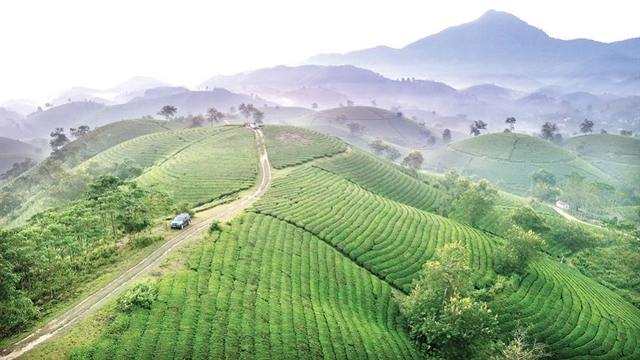 Politics & Law
Politics & Law

With its advantages fully recognised, the southern “emerald island” of Phú Quốc off of Kiên Giang Province is set to live up to its title of a special administrative-economic zone.
 |
| Bãi Sao beach, a popular tourist spot on Phú Quốc Island of the southern province Kiên Giang. The island district is striving to become a world-class special administrative and economic unit. — VNA/VNS Photo Lê Huy Hải |
HÀ NỘI — With its advantages fully recognised, the southern “emerald island” of Phú Quốc off of Kiên Giang Province is set to live up to its title of a special administrative-economic zone.
Many investors are flocking towards the “promised land,” especially since early 2014 when the island was connected to the national electrical grid via submarine cables.
On the sides of the main road from the coastal Dương Đông town – lying at the midsection of the island – to the southern tip, several hotels, restaurants, apartment complexes and resorts are under construction – the majority of these projects owned by big-name corporations, domestic and foreign. Similarly, to the north, tourist and entertainment complexes with scales ranging from vast to medium-sized have popped up in recent months.
Nguyễn Thống Nhất, head of the management board for investment and development of Phú Quốc Island, says that at the moment, 265 projects are underway or set to be operational on the island, covering a total area of 10,500 ha. Of this figure, 197 projects – covering 7,200ha, and with total committed investment of VNĐ218 trillion (US$9.592 billion) have only been granted investment permits, 31 projects have already become operational, 24 are undergoing construction, while the remainder are “finalising investment procedures.”
“Among these projects, 26 are foreign direct investment (FDI) with total capital set to reach $290 million,” Nhất told the Tiền Phong (Vanguard) newspaper.
Aside from the private sector projects, several large-scale public projects are being carried out throughout the island to meet the demands of an economy growing at 25-30 per cent a year, said Huỳnh Quang Hưng, Vice Chairman of Phú Quốc People’s Committee. Most notable projects are the Phú Quốc international airport (phase 2) with total investment of VNĐ3 trillion ($132 million); the 51.5km long north-south axis road – with investment of VNĐ2.5 trillion ($110 million) – which has achieved 92 per cent completion; and the 100km island-bound road, with investment of more than VNĐ3 trillion (68 per cent of the workload has been finished). Other projects include upgrading the An Thới fishing port, breakwater construction and dredging at the Dương Đông river’s outfall, as well as an international passenger port in Đông Dương.
Together with the influx of investment, the stream of tourists to the island has also seen a dramatic increase, said Huỳnh Quang Hưng.
The number of tourists coming to Phú Quốc in 2016 rose 63 per cent compared to 2015, and the first six months of 2017 saw a 44 per cent increase compared to the same period in 2016, while the number of international tourists increased by 77 per cent.
The island is also receiving an influx of people from the mainland looking for job opportunities.
Trần Văn Phương, 25, hailing from An Giang Province, came here 2 years ago to work as an ironworker for the numerous construction projects underway on the island.
“I can earn VNĐ300,000 ($13.2) for a day’s work, double the amount I get back in my hometown, in addition to free meals,” Phương said.
Despite higher living costs on the island than on the mainland, but offset by higher income, there is an increasing number of people from all over the country arriving here seeking jobs.
A tremendous amount of energy is required to drive the booming development of the island. According to Nguyễn Văn Minh, head of Phú Quốc Electricity Company, the average year-on-year electricity production growth rate is over 103.48 per cent. Electricity output has increased from 57.4 million kWh in 2013 to an estimated 297 million kWh in 2017.
However, accompanying this bubbling growth are numerous “headaches” that the authorities need to address, especially in terms of environmental protection, said the island’s vice chairman Huỳnh Quang Hưng. Waste treatment facilities on the island are still lacking – the waste treatment plant is still being built, a plan for a wastewater treatment system remains on paper due to lack of funds.
The stream of workers coming from other localities also pose an array of public order issues in certain areas.
In addition, Hưng said, the number of complaints and lawsuits concerning the land compensation rate is also on the rise.
Hopes are high for a special zone unburdened by common constraints and enjoying privileges other localities can only dream of.
Ass. Prof. Dr Trần Đình Thiên, head of the Việt Nam Institute of Economics, in a conference discussing policies for Phú Quốc, said that the competitiveness of the locality must be raised to an “outstanding level, of the highest order.”
To fully achieve its full potential and live up to its future status, Chairman of Kiên Giang Province People’s Committee, Phạm Vũ Hồng, stressed the life-and-death need for a new policy mechanism for Phú Quốc as a special administrative-economic unit.
According to Hồng, Phú Quốc “has an economy on a scale equal to that of a full-fledged province, but its governing body remains the same as one governing a district.”— VNS
Phú Quốc is the island district of Kiên Giang Province, with a total area of 59,000ha and a population of 120,000. The provincial authorities’ proposal to establish Phú Quốc as a special administrative and economic zone is still being developed, and is scheduled for submission to the government and National Assembly in October. However, according to already approved plans for the island, the focus of development for the island would be eco-tourism and luxury resorts, in addition to entertainment forms such as casinos and safaris. |




